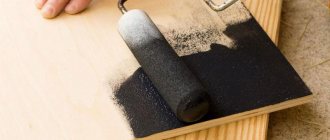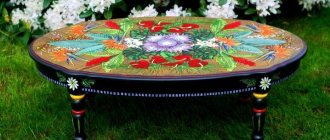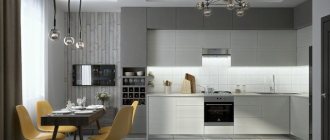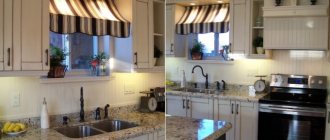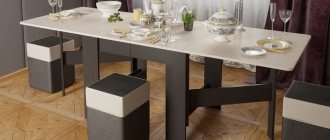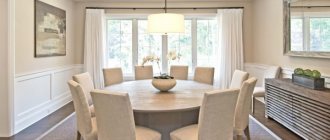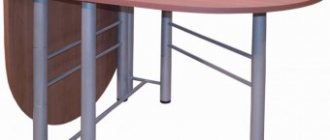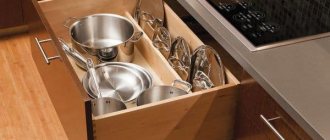Why is a wooden countertop not scary?
On the one hand, smooth, warm wood with a beautiful natural structure is an excellent material for furniture production. Easy to use, environmentally friendly, always fashionable and relevant. Moreover, the tabletop is not a heavy wooden buffet that is impossible to move. It is not necessary to make all the furniture from wood; a completely reasonable modern solution would be to make only the tabletop and, perhaps, some other individual parts from this material.
But many are afraid of how wood may behave, they are afraid of fungus, cracked varnish...
But professionals think differently: “A wooden countertop is not a problem if you apply reasonable, adequate care to it. There are not many materials used for countertops in non-professional kitchens that are not afraid of any impact and do not require maintenance, says Andrey Lyamin-Borodin, builder, general director of the online repair ordering service PriceRemont
. “All materials age during use, but the peculiarity of wood is that it can age gracefully.”
So what are we dealing with? Mikhail Vychuzhanin, wood finishing specialist, North House
, defines the advantages and disadvantages of wooden countertops like this.
- environmental friendliness of the material;
- beauty and variety of wood texture;
- unlimited product parameters: almost anything can be made from wood in any way;
- easy to update;
- the ability to perform any milling of the edge of the tabletop.
- more careful care is required;
- restoration will be needed after some time;
- relative high cost of the material and work with it.
Design and design features
There is a wide variety of colors and designs of kitchen sets from classic to modern modern. Here, as they say, “it depends on taste and color, but in any case, a wooden tabletop should add a slight contrast to the overall design of wall and floor cabinets. It will be great if it acts as a border between the top and bottom.
Darker shades will better hide minor surface defects that arise during use, and a white countertop will look harmonious in a kitchen with delicate shades and create a special coziness.
When choosing a product, do not forget that the countertops are made of wood, which means they are more susceptible to mechanical and aggressive influences.
Definitely the main highlight of the kitchen will be the product combined with any niche or window sill. This non-standard approach will allow you to combine business with pleasure.
Solid wood countertops of non-standard shape attract special attention, be it an oval for a kitchen island or another more complex geometric solution.
Also nowadays, wooden countertops for the kitchen with end edge processing in the form of milling of various styles are very popular.
Which wood to choose for the countertop?
Here is the answer to the question of what types of wood and wood characteristics are worth paying attention to.
“When deciding on a wooden countertop in the kitchen, please forget about MDF, chipboard and veneer. Only natural wood, advises Artyom Lepyoshkin, General Director of the House of Interior Solutions Dynasty
. It's not a matter of harmfulness, but of the properties of the material. The countertop is exposed to aggressive human influence every day: crumbling, cutting, whisking, spilling and spilling are a common occurrence in the kitchen. The surface must be durable, smooth, resistant to cuts, moisture and temperatures.
The classic option is oak or beech: strong and durable wood species. Some choose teak and mebrow. More affordable options: pine, walnut, ash, birch. We prefer larch: you will have to pay more, but it will also last longer. The peculiarity of larch is the very high density of wood; the growth rings are located along the trunk with small intervals. It easily tolerates mechanical damage and deformation, and can withstand high compression and pressure loads. It contains gum, a natural antiseptic that protects against rotting and damage by mold. Ideal for the kitchen. Larch gives off and absorbs moisture when humidity changes.
The manufacturing method also affects durability. A solid wood tabletop is more likely to warp than a laminated wood tabletop assembled from several plates. This method increases flexibility and elasticity.”
“Attention should be paid to such points as: the age of the wood, the method of its extraction, storage conditions, the region where the material was brought from,” adds Mikhail Vychuzhanin
. He considers oak to be the best type of wood for making countertops. — The stronger and harder the wood, the longer your countertop will serve you. There are countertops made from solid birch, cherry, and walnut.”
How to cover a wooden countertop in the kitchen
The ideal option for protecting a wooden tabletop is a bio-impregnation based on natural vegetable oils and beeswax - that is, oil-wax for wood. Natural oils for wood can make its surface waterproof, which means that the wood is not afraid of fungus and mold. By the way, a countertop impregnated with high-quality oil and wax becomes resistant to standard kitchen detergents—nothing bad will happen to wood from diluted household chemicals. It is even better and more reliable to treat the kitchen work surface with a special oil for wood that comes into contact with food. And of course, no one has canceled the more familiar coatings - interior varnish for wood or a combination of colored azure with subsequent application of varnish.
Oil, wax or varnish?
Caring for and proper use of a wooden countertop will extend its life.
A high-quality coating with good compounds will give a wooden tabletop a beautiful look and protect it from moisture and aggressive detergents.
In order for the tabletop to last longer and maintain its appearance, do not cut anything directly on the wood and do not test the surface for fire resistance and heat resistance.
How to cover a wooden tabletop so that it lasts as long as possible and at the same time remains beautiful?
- Oil, wax.
- Alkyd coatings.
- Water-dispersed compositions.
Depending on the coating, the same type of wood looks different: polyurethane gel, glossy varnish, wood oil
Ideally impregnated with oil, oil-wax. Oil, nourishing the wood structure, gives it water-repellent properties. When properly treated with good oil and wax, the countertop becomes resistant to household chemicals and detergents, which are often used for washing kitchen utensils.
The ideal option for protecting a wooden tabletop is a bio-impregnation based on natural vegetable oils and beeswax.
Apply the oil coating either with a brush or a rag evenly over the entire surface.
A special oil designed to impregnate wood that comes into contact with food will ensure environmentally friendly processing.
Oils for treating wooden countertops can be vegetable, synthetic or mineral
You can apply colored glaze, stain, and other water-dispersed coatings followed by application of varnish. The properties of the varnish used, its resistance to moisture, and multi-layer coating are important.
The varnish treatment option is better because the wood is coated with a protective layer, which is much stronger than oil protection.
A high-quality coating is carried out in several layers - two or three - regardless of the paint composition. Do not mix alkyd and acrylic coatings. Before covering the countertop with the base compound, it is important to select the appropriate primer.
Preparing a wooden table for varnishing
You can use a primer that matches the natural color of the wood, or a colored primer that matches the color of the varnish that will be used on the wood.
For maximum durability, the coating should be renewed one year after application. It takes time for the product to “get used” to the surface at different temperatures. When exposed to external conditions, microcracks appear on the surface of the coatings, which are visually indistinguishable. Therefore, it will be useful to lightly sand the top layer and apply a new layer with the same composition.
Sand the surface and apply a layer of varnish along the wood grain
Beech wood before and after treatment: on the left – untreated beech, in the center – after treatment with white oil, on the right – oil varnish
The quality of the coating can be tested in the following way: apply a few drops of water to the countertop and observe how quickly they are absorbed. A good coating has excellent water-repellent properties.
Exposure to water can only be short-term - otherwise the wood will have to be sanded and waxed again
It is important to consider the drying time of the compositions; it can vary from several hours to several days. Natural oils and acrylic mixtures have a long drying period or accumulate strength gradually over time, so it is important to limit the use of the countertop during the drying period.
It is impossible to protect wood from scratches and mechanical influences with paints and oils, so there is only one way out - treat wooden countertops with the utmost care.
Wooden countertops are an excellent solution for modern kitchens
The slight carelessness of the wooden surface will give the kitchen...humanity. Isn't that what we value most? Humanity... Kitchen? Why not?
A place for wood can be found in a kitchen in any style, it is only important to approach the matter correctly
A wooden countertop in the kitchen is a beautiful and high-quality material that will decorate your kitchen
How practical is a wooden tabletop?
How to protect wood besides using wood products?
If you want the tabletop to last longer and maintain its appearance, follow simple rules: do not cut anything directly on the wood (perhaps only oak will endure such violence), do not test the surface for fire resistance and heat resistance. Very hot objects can darken wood, ash is especially sensitive. But if you spill wine or juice on the surface, just wipe it with a damp microfiber cloth. Do not use wet rags, this will cause the wood to swell.
We also do not recommend using aggressive household chemicals to wash the countertops. It happens that drops of such a product fall on the countertop when cleaning the sink or hob. If this product contains, for example, a solvent, it can change the color of the wood and whiten it. An important rule when any stains get on the countertop is to not allow them to be deeply absorbed and, therefore, to remove them immediately. A stain that cannot be washed off can be removed by walking over the area with fine-grained sandpaper, after which the protective coating will need to be renewed.
Regarding the choice of sink - in this case it should be mortise or, in other words, overhead. Washing an under-table installation will create constant exposure to water on the edge of the tabletop, which will inevitably cause it to deteriorate. However, lovers of country style or owners of a tabletop made of particularly water-resistant wood may not be bothered by this.
Oil to the rescue: how to care for a wooden countertop
Wooden countertops are popular among housewives due to their environmental friendliness, beauty and variety of textures. However, there is a circumstance that is alarming - how to care for the work surface? After all, wood is a natural material that reacts sensitively to excess moisture and sun.
And here are other features of using a wooden countertop, ignorance of which can ruin the mood of the housewife and the appearance of the kitchen:
- hot objects will leave marks on the surface;
- Frequent treatment with a very wet cloth causes the wood to swell;
- wood can change color from too much sunlight;
- Do not use aggressive household chemicals. And if the care product contains a solvent, it will change the color of the wood.
Wood master Igor Bugaev explains what natural material the countertops are made from:
The classics of the genre in choosing wood for a tabletop are oak or ash. Beauty of texture, surface hardness, resistance to external influences. Teak and merbau are very popular. More affordable options include birch, elm and the most affordable - pine. Today, the array is often replaced with laminated boards made from the above materials. This improves performance, but such countertops can hardly be called a 100% natural product.
© Instagram @igor._.bugaev
A wooden tabletop is the dream of many housewives. And stars too. For example, actress, jewelry designer and mother of many children Anastasia Tsvetaeva showed her kitchen interior to subscribers of her personal blog:
Oak tabletop. No problems, she lives and nothing happens to her.
© Instagram @nastia_tsvetaeva
How to preserve the beauty of a wooden tabletop and extend its service life? Experts advise covering with natural oil with the addition of wax (or just oil). This treatment eliminates the risk of mold and mildew.
As soon as you notice that the texture of the wood has become more pronounced, worn out and the wood “seems to be drying out” or becoming lighter, it is necessary to impregnate with oil, the owner of a wooden tabletop shares her personal experience. — I get it on average once every 9-10 months. The oil has a hydrophobic effect and, penetrating into the wood structure, protects it from moisture and swelling.
Oil for caring for wooden surfaces
To work you will need:
- oil
- a clean sponge (you can use a brush or even textiles, whichever is convenient for you)
- lint-free cloth to remove excess oil
Work process:
- Apply the oil in a thick, even layer.
- Wait 15–20 minutes.
- Assess surface quality. If the oil has been absorbed, you may need to go over another layer.
- Remove excess oil with a cloth. It will take approximately 24 hours for final drying.
© Instagram @marishaivit
Tactilely, you can especially feel the difference between wood with treatment and wood without treatment. This is class,” the mom-blogger shares her impressions.
At home, you can use linseed oil to treat wooden countertops. Experts note that the tree will “take” exactly as much oil as needed. It is recommended to apply the second layer only after the first has completely dried. In this case, you will get a more protected surface. Thanks to oil impregnation, a wooden tabletop acquires a beautiful rich shade, a velvety surface and water-repellent properties.
It's time to save the countertop if during use it turns out that it changes its color to matte due to contact with hot dishes. As experts explain, the wood was treated with budget varnish. What needs to be done: treat the dry surface with oil. Such an ambulance will hide traces of damage.
The following mixture can also protect a wooden tabletop from damage: beeswax, linseed oil, rosin.
Wax for the care of wooden surfaces
Ingredients:
- 25 g natural wax
- 25 ml flaxseed oil
- 2.5 rosin
Preparation:
- Dissolve the wax in a steam bath.
- Heat the oil and combine with rosin.
- Combine all ingredients and heat again in a steam bath until completely dissolved.
- Rub the mixture into the countertop using a soft, lint-free cloth in a circular motion.
Will this countertop suit my design?
Wooden surfaces in the kitchen also offer wide design possibilities and are a current trend. Here's what designers think about it.
The world is becoming more urbanized, and people are experiencing stress due to lack of communication with nature. Natural materials in the interior, such as wood, stone, clay, help modern people feel comfortable in the “concrete jungle”.
Since wood is not a moisture-resistant material, the part of the countertop adjacent to the sink can be replaced with an artificial stone surface.
Thus, a tabletop made of solid wood with knots, uneven texture, and aging effects will suit a kitchen in a rustic or loft style. But smooth wooden surfaces will look great in modern interiors, high-tech, especially tinted in white, black or graphite - such a tabletop will combine effectively with chrome and glass surfaces. It’s worth paying attention to options made from laminated wood – perhaps even from different species: the rhythmic pattern of the elements can emphasize the beautiful geometry of the room.
kirsan_kaifat
25-12-2014 12:16
Hello. I was planning to make a beech (or oak) countertop for the kitchen from furniture panels. Unfortunately, we can’t find birch
3. Does anyone have birch shields?
sergVs
25-12-2014 12:38
1. How to change the color of steamed beech towards a lighter natural one?
quote: Originally posted by kirsan_kaifat: 2. What to cover with. impregnation or varnish?
Hard wood is better for impregnation, soft wood (pine, birch) - varnish.
kirsan_kaifat
25-12-2014 12:59
Beech, oak, ash. I’m also inclined to soak it in food flaxseed
Shyr3000
25-12-2014 14:35
vladimir beard
25-12-2014 15:36
Osmo oil with flax, especially for kitchen countertops
alex-wolff
25-12-2014 17:06
quote: Originally posted by kirsan_kaifat: 2. What to cover with. impregnation or varnish?
super unique, in three layers.
vvik
25-12-2014 17:30
That’s why parquet floors used to be rubbed with mastic, and not with varnish….
vvik
25-12-2014 17:31
As for the beech, don’t worry. In terms of performance characteristics, it is much better than birch
DocVV
25-12-2014 23:18
I suffocated from the flaxseed. You will spend months looking for a forgotten can of fish. It stinks for a long time, subtly but smelly, I'm for the varnish.
Walther
25-12-2014 23:31
Siniy Borod
25-12-2014 23:54
Wood is bleached with oxalic acid...
kirsan_kaifat
26-12-2014 10:14
quote: Originally posted by alex-wolff: super unique, in three layers.
This is what I use to cover homemade furniture.
because The kitchen is planned for spring, I have time to use any impregnation. and away from your place of residence)
kirsan_kaifat
26-12-2014 10:17
quote: Originally posted by sergVs: There was a recipe for lightening wood by treating it with peroxide and ammonia. I haven't tried it myself.
I bought a chlorine-based poison for testing. I'll torture the stool
quote: Originally posted by Shyr3000: Kiryukh, shellac doesn’t work anymore??? True, the color will turn a little red-yellow, but it will shimmer as it will....... And forget flax, it kills the beauty of the tree Z.Y. Please indicate the size of the tabletop you require... There was something similar made of birch in the store, I’ll take a look and post it.
maximum size 1500x600x40. I'll have to make a couple more smaller pieces there
quote: Originally posted by vvik: European professionals have been using toadflax and only toadflax for centuries. The reason is that any damage to the tabletop can be easily sanded, sanded and impregnated with flaxseed. No trace. It is impossible to restore any other coating on a small piece of surface without traces. That’s why parquet floors used to be rubbed with mastic, and not with varnish….
Thank you
quote: Originally posted by Siniy Borod: Wood is bleached with oxalic acid...
Thank you!
quote: Originally posted by Walther: I have an oak kitchen countertop with a total length of 8 meters. Finished with Ikea countertop oil. Both in the tail and in the mane. Super! Serves for 5 years, has not been re-processed yet. edit log
I looked at their impregnation.
same danish) they just write without drier. Max_CM
26-12-2014 10:51
Flaxseed, Danish, oil from IKEA (simple and affordable) Varnishes and especially Schellak are not suitable at all. because they create a film coating, there are fairy tales about the water resistance of shellac, even on the film of yacht varnish, if you accidentally chop it with a kitchen knife, a trace will remain.
Nowadays there are many different parquet oils, they have a natural base, are perfectly absorbed, do not create a film, in case of damage it is easy to restore, in addition, they can be tinted, that is, when applied, the tone will remain in the looser places of the texture, emphasizing it. Beech for countertops is much better than birch; birch can warp greatly.
arkuda
27-12-2014 02:03
I would be careful with beech - it really doesn’t like moisture (unless it has undergone some tricky treatment) and tears it up. But oak will be more reliable, and ash too.
kirsan_kaifat
28-12-2014 22:24
It will be impregnated before installation. there is time)
bigdad
13-01-2015 13:21
For twenty years he worked as a kitchen assembler. To impregnate the countertops made of natural wood, they were supplied with an oil like Danisha (I don’t remember the name). The tabletop was impregnated twice: the first layer was rubbed over the surface and after 2 hours of drying, the second layer was applied, which was left to dry overnight. The beech pattern became a little darker and more saturated, but not by much. I used a piece of such a countertop for five years to chop frozen meat and bones, there were no delaminations until I chopped it too hard and broke it.
kirsan_kaifat
13-01-2015 13:49
Thank you. I also found a solid birch shield. maybe I'll make one out of it
PavelTsirkach
14-01-2015 04:00
quote: The flaxseed made me choke. You will spend months looking for a forgotten can of fish.
Yongert
14-01-2015 04:38
the most important thing is to cover equally on all sides - for example, 3 layers on top - also three layers on the bottom
kirsan_kaifat
14-01-2015 11:20
quote: Originally posted by Pavel Tsirkach: Now in shops for artists they sell REFINED linseed oil, absolutely odorless.
I even saw it in the grocery store.
quote: Originally posted by Yongert: the most important thing is to cover equally on all sides - for example, 3 layers on top - three layers on the bottom as well
What is this connected with?
Yongert
14-01-2015 12:08
with the fact that if the sides have different vapor-water permeability, then the shield may fail during operation
kirsan_kaifat
15-01-2015 11:29
RMCKursk
19-03-2015 13:17
Google Rubio Monocat. Flaxseed oil, Naturel color (will lighten the countertop), apply in one layer, after 10 minutes wipe off the oil until the wood is dry. It will smell like linseed oil for two days. But then even if you put the pan on hot, there will be no trace. A 0.275 can is enough for 12 squares. So if it’s damaged, wash it, sand it, polish it and it’s like new.
demonis
19-03-2015 19:50
I'll give one more vote for OSMO. My desktop is covered with it. the table is entirely made of solid oak. I tried ZAP, Tikkurila - not the same. The effect is not the same, it also stinks. OSMO is just a blast. what about application, what about the result. I spent more money while looking for an acceptable result than OSMO cost.
Zmeyuka
19-03-2015 23:39
If OSMO is expensive, then Borma (Premier Coating) has oils for countertops or even floors. Doesn't smell like anything. Or better yet, white oil, two layers according to the instructions, and grundieroil then two more layers. Tomorrow I will add a photo of my kitchen under construction under this composition
The surface of the table in the kitchen is an essential part of kitchen furniture; it is subject to constant mechanical stress and is damaged over time. Therefore, owners of kitchen furniture ask themselves an important question: - How to cover the countertop so that it does not lose its presentation for many years?
In the kitchen, the top of the table or the area located on top of the floor cabinets is used as a work area for cutting food and preparing food, as well as a place to place household appliances and kitchen utensils. Such a working area must be resistant to shock and various mechanical damage, to the effects of temperature, ultraviolet radiation and water.
Features of wood countertops
Kitchen sets are made using various raw materials, such as wood. It can be either natural, that is, without a special composition applied on top, or coated with varnish or paint.
The table provides data on wooden tables.
The advantages of countertops made of wood are:
- a large number of different forms;
- attractive appearance;
- ease of carrying out restoration work;
- This material is environmentally friendly and warm.
The disadvantages of countertops made from wood raw materials are:
- ease of fire;
- ease of contamination;
- can be scratched easily;
- is quite expensive.
Required Tools
Before creating a wooden countertop for your kitchen, you should check that you have all the necessary tools and materials. These include:
- cutter (automatic or manual);
- jointer;
- hacksaw;
- perforator;
- drill;
- hammer;
- fastening elements (nails and screws);
- sandpaper;
- thicknesser;
- clamps;
- wood glue;
- varnish or paint;
- brush;
- the wood itself.
Advice. To finish the wood elements, it is convenient to use a jointer or order the services of a carpenter to finish the elements from the nearest carpentry services company.
Before assembling a wooden kitchen countertop with your own hands, all its parts must be thoroughly dried - otherwise this process will take place after the creation of the product, which will lead to its inevitable deformation.
An automatic jointing machine for making panel tabletops can be rented from a special company
Ways to protect your kitchen work surface
The working area of the room in which food is prepared is exposed to various liquids, so in order for it to serve for many years, it must be protected from water.
There are several ways to do this:
- Use oil to treat objects made of wood, which is absorbed into the material and prevents the fibers from swelling when wet. The following industrial products can be used for wooden surfaces: OSMO TopOil, Belinka, Adler Legno or many others. To treat the work area together with this substance or even instead of it, use a special wax. But it is necessary to remember that such a product will have to be renewed over time, that is, applied again.
- Treat it several times with a special varnish for wood surfaces. If desired, a little pigment is added to it so that the deep fibers of the wood become darker, and the cooking surface itself acquires expressiveness.
Oil coating for kitchen units
Oil protects furniture from not only moisture, but also from chemical, natural and household influences. This industrial product is largely colorless and can be plant-based, mineral-based or synthetic.
These coatings differ from each other in the drying method:
- It dries completely, hardens after drying, it cannot be washed off with water and the original appearance of the treated furniture is preserved for quite a long time.
- It does not dry at all or dries only half and saturates the wood quite deeply. It is made using natural ingredients. It is removed using mechanical force.
Before applying such a product, the surface to be treated is thoroughly cleaned of all contaminants and dried. If necessary, old paint or varnish will have to be removed. And if there are defects, they must be leveled with a special putty and then sanded with sandpaper.
The oil is applied using a brush or cloth that does not leave lint, it is applied along the entire length of the fibers. The very first layer should dry for twelve hours, then a new layer is applied. Their total quantity in this composition depends on the method in which the product itself will be applied. If a brush is used, two treatments will be done. And when using a rag, you need to do three or four layers. After the composition is completely absorbed, the entire treated area should be wiped well with a soft and clean cloth.
The presented coating has a number of positive properties:
- Does not change the color of the surface for working with food, emphasizes its “pattern”.
- It leaves the original natural exchange of moisture in the surface and prevents the appearance of fungi, so the original appearance of the treated area does not change for a long time.
- If the outer part of the object for such treatment is exposed to elevated temperatures, then the product does not delaminate and does not flow.
- Furniture oil is environmentally friendly, so contact of food ingredients with a surface containing the described composition will not harm human health.
- Oil hides small scratches, worn areas and stains left by cookware.
- If there is a need to renew contaminated areas, you can remove only part of this coating, and then reapply it to the desired areas.
- The oil is well suited even for aged wood containing pores, as it is deeply absorbed, gives it elasticity and prevents it from drying out.
How to restore a wooden table
Before you varnish your dining table or kitchen worktop, you should evaluate the condition very carefully. The surface may already be painted, mechanically processed, glossy, or varnished. Regardless of what varnish the surface will be coated with, it is necessary to carry out preparatory work.
In the video: how to cover a table with stain.
Preparation
The first step is to remove all the old coating. This is done so that the texture of the wood is clearly visible, using an electric tool. When the table is as smooth as possible, the surface does not have any defects, then you can move on to the next stage.
To work, you will need a roller or brush, and you will also need to purchase a remover liquid to remove the old paintwork. You will also need a primer and stain, a hair dryer, and sandpaper with varying degrees of grit.
Removing old coating
The chemical remover is applied to the table surface and then wiped off after 10 minutes. To apply and remove a layer of paint or varnish, use a rag.
There is also a hot method - you need a hair dryer. The tabletop is heated and then wiped with a rag.
You can also remove the old coating by sanding. Doing this by hand takes a very long time, so it is better to use a power tool. The work is performed at low speeds so as not to damage the wood.
Varnish application technology
To apply varnish, it is better to use brushes or rollers. Using a colorless varnish for a wooden table in one layer, it is very difficult to obtain the desired shade - this is only possible if you cover the surface in several layers.
A more saturated color can be achieved by treating the table with stain or colored primers - they are applied either in one layer, or in two, three or more.
After the stains and primers have dried, they can be varnished. The varnish is applied in a thin, even layer, trying to avoid drips. After the first layer has dried, it is recommended to sand the surface. For a high-quality result, varnish in three layers of varnish.
In a day, the old table will turn into a new one and no one will ever be able to say that it is very old. Knowing how to cover a table, you can restore other wooden furniture in this way.
How to use wood varnish correctly (2 videos)
Everything you need to varnish a table (29 photos)
The kitchen is the heart of our home, a place where everyone visits at least once a day, and for many families it is also a place where the whole family gathers every day, for cozy communication, and intimate conversations. For many housewives, the kitchen is the place where they spend the vast majority of their time, and the convenience and beauty of this place largely determines whether working in the kitchen will be a heavy duty or a joyful creative process.
When buying a kitchen, many people spend a lot of money on the kitchen itself and its equipment, but often do not pay enough attention to such an important detail as the countertop. But it is the countertop that is used in the kitchen every day, comes into contact with food, is exposed to various influences, is cleaned and wiped many times more often than, for example, kitchen facades. That is why for a long time, even ardent adherents of natural materials in home decoration were unable to afford such luxury as countertops made of natural wood. After all, when choosing a wooden tabletop, many questions arose. First of all, how to properly protect a wooden tabletop for a long time? How to cover a wooden tabletop and how to care for it. Is it possible, if necessary, to update the appearance of the countertop and remove traces of damage? In addition, the composition of the countertop coating is of particular importance, because it must be harmless to food products that will come into direct contact with the countertop.
Now, to the great joy of those who want to acquire a wooden countertop, an ideal solution to all problems has appeared. offers the most environmentally friendly Top Oil with hard wax, developed specifically for wooden furniture and tabletops, from the German manufacturer of natural wood preservatives OSMO.
+
For furniture and countertops (including kitchen ones)
+
Leaves wood pores open
+
Has a water-repellent effect
+
Does not crack, peel, or peel
Consumption: 1 liter per 12 m2 in two layers
Product Description
This oil contains a special combination of natural oils and waxes suitable for processing furniture and kitchen countertops. The wood remains natural, while the natural color and structure of the wood are emphasized. The treated surface acquires wear resistance, dirt and water repellent properties. Any stains can be easily removed from it. Areas subject to heavier traffic can be easily renovated. To do this, it is necessary to clean the damaged area from contaminants and apply a new layer of countertop oil; there will be no noticeable differences from the previously treated surface. No sanding required! Oils for furniture and countertops are based on natural vegetable oils and waxes. Due to this, the pores of the wood remain open, and the coating is not subject to cracking, peeling and peeling. The treated surface is resistant to cleaning agents, drink stains, water and complies with DIN 68861 – 1C. Colorless oil for countertops does not require special skills to apply. The shine of the treated surface can be enhanced by additional polishing.
Oil base
A special combination of natural oils and waxes of plant origin. Deep penetration into the wood structure and protection from drying out. Vegetable oils do not interfere with the natural moisture exchange of wood, thereby reducing the risk of swelling and shrinkage.
Safe for health and environment
Osmo countertop oils do not contain biocides or preservatives that negatively affect human health. The dried oil does not pose a danger to humans, animals and plants and complies with the German standard “Safety for possible contact with skin and saliva”. Osmo's strategy is to produce and sell products that are safe both during production and operation.
Usage
Designed to protect wooden furniture, solid and laminated wood countertops (kitchen countertops, etc.). For indoor use. For tropical hardwood products, the use of Klarwachs Hardwood Oil and Wax 1101 is recommended.
Number of layers
When working with a brush, 2 layers are recommended. When applying oil with a rag or napkin, three to four layers are required. To renew the coating, 1 layer is enough.
Preparatory work
Osmo paints and oils must be applied to a clean and dry surface (wood moisture content should not exceed 20%). It is not recommended to carry out work at temperatures close to zero degrees and below. This can lead to a significant increase in paint and Osmo oil consumption, as well as to the fragility of the coating. When initially treating a wooden surface with Osmo paints and oils, it is recommended to apply them to clean wood that is not coated with other paints and varnishes. It is also possible to apply it to an old open-porous coating, but it must be cleaned of dirt and dust. Old wood coverings (regular paints and varnishes) must be removed. Small cracks and damage to wood can be smoothed out using wood fillers if desired. Sand the surface of the wood thoroughly, starting with coarse (coarse-grained) sandpaper and moving to finer ones. It is recommended to carry out final sanding with paper grit P100-150 for floors (walls, ceilings) and P180-320 for furniture. Immediately before using the oil, you need to remove wood dust and dirt, first with a broom and then with a vacuum cleaner. In rooms with high humidity, wood susceptible to blue staining (spruce, pine, etc.) is recommended to be treated with Holzprotektor impregnation with a water-repellent effect. Then apply a finishing coat of any Osmo paint for interior work.
Application
Oil and wax for furniture and countertops is ready for use. Stir thoroughly before starting work! It is not recommended to dilute! This can lead to the fragility of the coating and a decrease in the degree of protection of the wood. Apply with a brush with natural bristles or a lint-free cloth in a thin layer along the wood grain. Leave to dry for 10 – 12 hours. Ensure good ventilation of the room. Apply the second layer in the same way as the first and leave to dry for at least 10 - 12 hours.
When tinting furniture and countertops, use transparent paint based on oils and wax (colored oil) Dekorwachs Transparent (see instructions for use) then apply 2 finishing coats of countertop oil using the technology described above.
Drying time
To apply the next layer or to be able to use a surface treated with oil for furniture and countertops, 8 – 10 hours are required. During the drying process of the oil, it is necessary to ensure ventilation of the room, because the oil dries out during the oxidation process and for this it is important to ensure good oxygen access.
Surface repair and restoration
No sanding is required to restore oiled surfaces for furniture and countertops! Clean the wooden surface from dirt and dust and apply oil in one layer. Allow the new coat of oil to dry thoroughly. Polish if desired.
Best before date
Osmo paints and oils can be stored for more than 5 years if stored in a tightly closed container (without oxygen) and in a dry place. Osmo paints and oils are frost-resistant! At temperatures close to zero degrees and below, paint and Osmo oil thicken. In this case, before use, it is necessary to keep the oil at room temperature for 1 – 2 days.
I want a free Paola AF catalog I want a free OSMO catalog Did you find it cheaper?
Provide protection from stains.
Keep your countertop clean to protect it from stains. Stains, dirt and grayness can form on the surface of a wooden countertop if it is not cleaned regularly.
- Remove any puddles or debris to prevent the stain from being absorbed by cleaning the areas immediately.
- Wash the wood with warm water and soap.
- Rub the stain with lemon juice. Clean the surface thoroughly to enhance suction power, sprinkle with salt and lemon juice.
- Mix 1 tablespoon of hydrogen peroxide in one glass of warm water. Pour some of the solution onto the stain. Wait a few minutes. Wipe with a piece of cloth.
- Use wood bleach or oxalic acid to remove the stain. Rinse the area with water to remove any remaining chemicals.
- Sand the wood countertop to restore a fresh surface. First use 120 grit sandpaper to remove the stain. Then use 180 grit sandpaper to sand the surface.
- Do not use vinegar to clean wood countertops unless the wood has been sealed. Vinegar can dissolve the glue that holds the wood together and cause the wood to become loose or cracked as it eats away at the wood.
Temper the wood in the same way that a cast iron pan needs to be seasoned.
- Pour a sufficient amount of warm mineral oil onto the countertop. Oils help prevent warping and cracking. The wood will absorb the amount of oil it needs, so don't worry about using too much oil.
- Make sure you use edible oil. Do not use oil for cooking. Over time, such oils will turn rancid when exposed to air and emit an unpleasant odor.
- Use a rag to rub the oil into the wood.
- Rub the oil in the direction of the wood grain.
- Allow the oil to soak into the wood for 20 to 30 minutes.
- Wipe the surface with a cloth or paper towel to remove excess oil.
- Fill the cracks with wax.
The wax fills any open pores and small cracks or scratches.
- Melt paraffin or wax in the microwave and add to mineral oil in a ratio of 1:4.
- Allow the countertop to cool and dry, and wipe again with a cloth to polish the surface.
- Reapply wax once a month to maintain the surface.
Apply this solution to wood surfaces while the wax remains warm. Spread over the entire surface with a cloth.
If you leave the countertop as is, water can damage the wood. Other liquids and food can stain the wood.
- Apply a polyurethane coating to the countertop surface. The sealed surface makes the countertop easy to clean, but is not recommended for the use of cutting objects.
Select a urethane that is certified to be food contact resistant.
Clean the surface of any harmful bacteria.
Wood kills a lot of bacteria, so naturally it's a good choice for a countertop material. The countertops are made of hard wood, which does not allow bacteria to penetrate inside. However, you should clean your countertops using special products that remove surface bacteria.
Updating the tree workspace
No matter how carefully the work area in the food preparation room is used, over time it still loses its original appearance. After which you can either buy a new headset or try to update it. Painting is the easiest way to update.
To paint the work area, do the following:
- clean the tabletop with sandpaper or a sanding machine;
- cover up all defects with special putty;
- walk over the surface to be treated with paint containing alkyd resin; the very first application of this paint will serve as a primer;
- if you wish, you can decorate the surface for kitchen work (draw something yourself or using stencils).
You can decorate the working part of the kitchen furniture using the decoupage technique. This technique consists of gluing decorative napkins onto the item being renewed, and then varnishing them several times.
Another way to update is to use a film of self-adhesive material, which allows you to give the updated item the appearance of a wood surface, stone, marble, leather or metal. Before gluing, the part of the furniture to be treated will have to be washed thoroughly, wiped dry and be sure to degrease.
Before using self-adhesive film, determine the dimensions of the area that needs to be updated in order to cut the film correctly. Pieces of this film should be cut slightly larger than the table itself. After gluing, do not leave any bumps or folds on the film. Smoothing the film is done with a plastic scraper.
Restoration of artificial stone countertops
Despite the strength of this material, flaws may appear on it and you can get rid of them at home. To remove a scratch from a kitchen countertop, a mixture of polyester resins is required, which makes even significant defects invisible.
The restoration proceeds as follows:
- around the damaged area it is necessary to clean the surface and degrease it;
- particles of material are removed from the recess, it is expanded and made deeper;
- the damage is covered with polyester resin and left to dry for 20 hours;
- Afterwards, the tabletop is sanded, first with an abrasive material and then with felt.
This kind of work is quite painstaking and requires certain skills in working with the tool. Therefore, if you have no experience, you can contact a specialist.
Caring for your cutting board
No matter what material the kitchen countertop is covered with, it is better to cut food not on it itself, but on the surface of the cutting board. The raw materials for creating a cutting board can vary. Kitchen boards can be made using plastic, special glass or wood (most often chosen because it is a natural antiseptic).
A new cutting board needs to be soaked, for which oil is suitable. This impregnation will protect it from liquid, food and bacteria getting inside it.
The oil layer of the board should be harmless to health and resistant to various damages. If you use sunflower or olive-based oil to cover the cutting surface, it may deteriorate after some time, and the board will need to be thrown away. Products based on coconuts or flax are expensive, but will not allow the cutting surface to become unusable.
Mineral-based oil is a good option for coating a cutting board. To do this, wipe the cutting board with it, wait until the composition is absorbed, and wipe it with a dry cloth. The procedure must be repeated once every thirty days.
Beeswax can be added to this cutting board coating to add density to the coating. Wax will increase resistance to moisture and prevent aging of the cutting board. After applying the oil and wax, you will have to let the product dry and then polish the outside of the board until it shines.
You should also remember to disinfect the board for cutting ingredients for preparing dishes.
You can disinfect cutting boards using these methods:
- hot water and detergent containing surfactants;
- vinegar;
- hydrogen peroxide;
- chlorine-containing bath cleaning products.
Restoring a wood countertop
Under the negative influence of liquid and high temperature, the top of the table may become higher, become loose or delaminate, after which the wooden surface must be restored.
Restoration is carried out as follows:
- all damaged areas must be removed;
- dry and sand the outer part of the table to be restored;
- make a mixture containing sawdust and polyvinyl acetate glue;
- fill all the empty spaces in the table that appeared after sanding with the resulting mixture; wood putty is also suitable for these purposes;
- leave the restored item under pressure until it dries for about one day;
- As soon as the table is completely dry, it must be protected with a product containing silicone, oiled or varnished over the entire area of the object.
To remove small scratches, you can wipe the problem area with strong brewed black tea, a walnut kernel, a mixture of vinegar and olive extract, and you can also use machine oil.
If there are scratches on a wooden surface that are deep, then sandpaper is used to sand it, and then sanding. And to give the effects of glossiness and shine, you will have to use felt.
As a result of all of the above, we can conclude that to keep a wood kitchen countertop in good condition, it is best to coat it with an oil-based compound with the addition of wax. And to preserve the board for cutting food, it would also be good for her to do this application. Then these items will serve for a long time, provided that their protective coating is updated in a timely manner.
In the vast majority of cases, kitchen countertops are wooden surfaces, since wood is a common and relatively affordable option. Environmental friendliness and good appearance are its advantages. But at the same time, we must not forget the susceptibility to destruction due to numerous external influences. However, this problem can be solved, since covering the countertop with protective components will help make the wood strong and durable, and will further improve its appearance.
- Wooden countertops, unlike plastic ones, are environmentally friendly;
- Unlike countertops made of natural stone, wooden counterparts are cheaper;
- Naturalness in design. Attractive appearance;
- Ease of restoration.
Disadvantages of wood as a component of kitchen furniture
The kitchen is characterized by strong temperature changes and high humidity, which has a very serious effect on wood, in contrast to the same stone and especially high-quality plastic. At the same time, if we talk about the countertop, it is also necessary to note the impact of fats, detergents, knives and the like found in the kitchen. The above-mentioned plastic and natural stone again win in this regard.
Finally, a high-quality work surface made of good wood can be significantly more expensive than plastic, although cheaper than natural stone. Well, don’t forget the danger of fire.
Oil is the best way to protect wood
It doesn’t matter whether we are talking specifically about the countertop in the kitchen, or about other wooden furniture products, today varnish protection is practiced less and less. The reason is that the varnish is not very environmentally friendly due to the large number of synthetic components. Well, in the case of this element of furniture, where food preparation takes place, the absence of harmful chemicals and naturalness is very important. At the same time, the varnished surface is often scratched and needs to be renewed.
Modern oil formulations do not have all these disadvantages. By applying them to the sanded, untreated surface of the wood, we create a layer on it that has excellent resistance to water and other influences. At the same time, the texture of the wood does not change, and the oil itself does not have any unpleasant odors, unlike varnishes. It is worth noting here that there are both natural and synthetic oils, as well as mineral ones.
All wood oils are divided into two types - those that dry immediately and those that dry partially. The former themselves provide very serious protection for a wooden tabletop, creating a durable hard layer on its surface. The latter impregnate the wood to a certain depth. In this case, the top layer of oils can be removed, and, for example, wax can be applied on top.
Main types of wood varnish
In order for a wooden table to get a second life, you need to choose the right material. The modern market offers a lot of options and the choice is very difficult. You should choose a product that will both improve aesthetic characteristics and reliably protect the surface from any negative influences. If even minor damage occurs on the surface, it will remain a reminder for many years, so the choice should be taken very seriously.
Alcohol based varnish
Alcohol-based varnish will create transparent or translucent coatings that will have a characteristic glossy sheen. At the same time, these materials provide reliable protection to the wooden surface. If you do not violate the technology during application, then using alcohol-based products you can effectively emphasize the beauty of natural wood.
These coatings contain resins dissolved in alcohols, which form a durable film. It is worth remembering that the stronger the alcohol, the stronger the film, and the most durable coating is formed when using a composition where the alcohol in the composition is stronger than 90%.
Oil varnishes
These are dissolved resins and pigments in oils. These products have a thick consistency and are affordable. After application, a fairly durable film is formed on the surface, resistant to various negative influences. This coating is ideal for restoration work on wooden furniture. These paintwork materials are especially effective if the table is in the open air all year round.
It is important that a wooden surface that has been coated with oil varnishes will, after drying, receive a stable yellow tint that will not go away over time.
Nitrocellulose varnish
These are solutions of nitrocellulose in organic solvents. Despite their excellent performance characteristics, these materials are toxic, harmful to human health, and even after drying they have an unpleasant odor. The industry produces much less of these compounds and nitro varnishes are now being actively replaced by alcohol varnishes.
Water based varnish
With this composition you can get an excellent coating that is completely safe for humans, pets and the environment. The composition is based on acrylates dissolved in water. After application to a wooden surface and drying, a protective layer is obtained that is resistant to mechanical stress, moisture, and UV rays.
Polyurethane varnishes
This option has high elasticity characteristics. The table covering perfectly withstands high mechanical loads, including impacts. These materials have a high drying rate. At the same time, the resistance to exposure to water and moisture is quite weak. The varnish is completely safe, the coating does not turn yellow, has a beautiful appearance and good transparency.
Among the advantages is that no preliminary priming is required.
What are the benefits of oil in protecting countertops?
- Complete safety in contact with food, which is important for the kitchen;
- Oils allow you to mask scratches and minor damage to wood;
- Resistance to high temperatures. Such oils do not separate and do not become liquid;
- When applied to old wood, the oil protects the latter from drying out and destruction;
- If you need to renew a damaged fragment, you can do this as simply as possible using oil. This will not work with varnish;
- Oil-impregnated wood retains the possibility of natural moisture exchange, which prevents the appearance of fungus.
Process of oiling a wooden tabletop
Before starting work, you need to make sure that the wood is clean and that there are no remnants of the old paintwork on it. In this case, the surface must be carefully leveled and sanded. The recesses can be filled with putty.
Important! To apply the layer you must use a brush or soft cloth. The main thing is that the latter does not leave traces.
Working with a brush, it is enough to apply two layers. In the case of fabric, at least four are needed. When applying each subsequent layer, you must wait until the previous one dries. The process usually lasts 12 hours.
Tabletop film
There is another way to protect the wooden surface of the tabletop - by applying a self-adhesive film to it. This surface has a number of advantages:
- The film does not allow water to pass through and also withstands the effects of various liquids and household chemicals;
- Film designs are varied. The material can imitate various surfaces, or have a design or pattern;
- If you want to update the appearance, you can remove the old film and install a new one.
As a disadvantage, we can remember that this element is still artificial, which neutralizes all the above-described advantages of wood. In addition, when applying the film you must be careful, since the slightest mistake can lead to the appearance of folds and other defects that spoil the appearance of the wood.
How to protect a wooden table?
The work area in kitchens is exposed to various liquids every day and is in conditions of constant high humidity. In order for furniture to serve for many years, it is necessary to protect it from moisture.
Today, several methods are used to protect wood:
- The surface is coated with a special oil, which is then absorbed deep into the wood, preventing the wood fibers from swelling when exposed to moisture. Experts recommend using the following products for wood: OSMO TopOil, Belinda, Adler Lengo. To cover the countertop and protect it as much as possible, special wax compounds are used along with oils. But you need to remember that such protection periodically requires updating.
- Treat the wooden work surface with special varnishes for wood products. You can add a coloring pigment to the composition to darken the deep wood fibers, while making the table plane more expressive. Coating a table with varnish is much easier than using oils and other products.
How to prevent damage to your countertop
Even taking into account the relative fragility of wood, its proper use can significantly extend its lifespan and maintain its original appearance. All that is necessary for this is to follow a few simple rules.
Do not wash the surface of the countertop with aggressive chemicals not intended for this purpose. Try to choose the right cleaning product and do not delay cleaning.
Despite the fact that the countertop is still a work surface, it is still better to use an appropriate cutting board. The cutting board can be plastic or wooden. In the case of the latter, certain care is also required:
- To increase its protective qualities, as in the case of a countertop, a wooden cutting board can be coated with oil or antibacterial impregnation;
- A simple remedy is regular sunflower or olive oil. To maintain the protective effect, it is recommended to apply at least once a month;
- Remember to thoroughly wash your board with hot water after each use and dry it thoroughly. As a preventive measure, you can wipe the board with hydrogen peroxide or vinegar. If there is serious contamination, use detergents.
If you still can’t protect the tabletop
Most often, damage to wood appears in the form of chips or dents. In this case, the wood often rots, and these areas also need to be removed, which again leads to the formation of voids that need to be filled. In this case, you need to perform several actions:
- Thoroughly clean the surface of the wood, and also treat it with sandpaper or a grinding machine;
- Place a mixture of sawdust and putty or polyvinyl acetate-based glue into the recesses. Then place it under a press and let it dry for several days;
- Before painting or otherwise treating the surface, it is important to give the sealed areas a smooth appearance.
How to restore the surface?
If the worktop cover in the kitchen has not only lost its original appearance, but has begun to collapse, you will have to carry out more serious restoration work. Under the influence of moisture and temperature changes, the table cover may become deformed (one half will become higher than the other), and the wood may swell and delaminate.
The recovery process looks like this:
- Remove all damaged areas of wood using a special tool;
- Dry and sand the lid with a machine (if you don’t have a machine, you can use sandpaper, but you will have to sand very carefully);
- Make a mixture of fine sawdust and polyvinyl acetate-based glue (you can use putty instead);
- Fill with this mixture those areas from which damaged wood and voids that may have occurred during sanding have been removed;
- Place the product under the press and dry for one day (this is the minimum period, more is possible).
How to cover a wooden tabletop after the adhesive has dried? An oil- or silicone-based product, or a special varnish, is also suitable here.
Important! The protective layer needs to cover the entire area of the product, and not just the restored areas.
